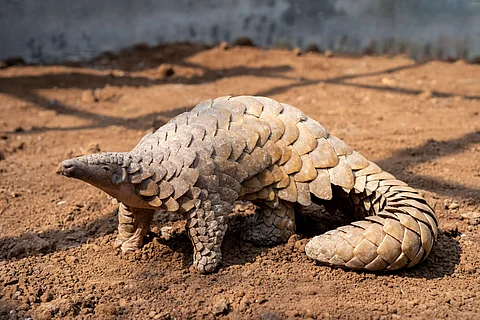

Global trafficking of pangolin scales and elephant ivory has sharply declined since 2020, with a new report attributing the drop to pandemic-related disruption, sustained enforcement and changing smuggling tactics.
The report, Disruption and Disarray: An Analysis of Pangolin Scale and Ivory Trafficking, 2015–2024, published by the Wildlife Justice Commission (WJC), observed a marked decline in large-scale seizures over the past four years, suggesting a shift in the criminal landscape.
The analysis noted that seizures remarkably plummeted after two major consignments of pangolin scales were intercepted within days of each other in 2020. Authorities in Singapore seized approximately 25 tonnes of pangolin scales in two separate operations, while parallel significant ivory seizures were reported in Vietnam, Singapore and China, also amounting to over 25 tonnes in total.
Pangolin scales are considered valuable in traditional Chinese medicine by many practitioners.
In 2019, global pangolin scale seizures reached an all-time high of more than 100 tonnes, the report stated. Elephant ivory seizures that year also peaked at 50 tonnes the same year.
These massive hauls pointed to transnational organised crime networks operating at an industrial scale, with access to substantial financial resources, business infrastructure and corrupt facilitators — all necessary for moving large shipments across continents.
Between 2015 and 2024, over 370 tonnes of pangolin scales were seized globally. This was estimated to correspond to the illegal trade of between 100,000 and one million pangolins. During the same period, over 193 tonnes of elephant ivory were confiscated, linked to an estimated 19,300 elephants, the analysis stated.
By 2016, seizures of pangolin scales began to surpass those of ivory, even though ivory volumes were initially nearly double. Pangolin trafficking continued to rise until 2019, while ivory seizures appeared to shrink.
The report attributed part of this shift to China’s domestic ivory trade ban, implemented in December 2017. However, 2019 saw a sharp reversal, with ivory seizures spiking by 146 per cent compared to 2018, challenging assumptions of a steady decline.
Following record-breaking seizures in early 2020, both markets experienced drops. Pangolin scale seizures fell by 75 per cent and ivory by 94 per cent that year, largely due to global pandemic-related disruptions.
By 2024, the volume of seized pangolin scales and ivory had declined by 84 per cent and 74 per cent respectively compared to 2019 levels. “It is notable that the total number of pangolin scale and ivory seizures remained reasonably similar in the 2020-2024 period compared to the five years prior to the pandemic, which could point to a relatively stable capacity of law enforcement to detect and intercept illegal shipments,” the report stated.
The analysis attributed the overall decline to multiple factors: Sustained enforcement efforts, disruption of trafficking networks, a fall in wildlife commodity prices, regulatory restrictions by China and increased risks for traffickers, among others.
However, intelligence gaps may have obscured the true scale of illegal trafficking of pangolins scale and ivory consignments in Asian supply chains. The report noted that traffickers may be successfully adapting with new modus operandi, using tools like encrypted communication methods on social media — such as voice notes and concealed images — to evade detection.
The shift in methodology might also include a preference for smaller shipments. While most pre-COVID consignments were transported via air cargo, post-pandemic trafficking reportedly moved towards sea freight, the analysis observed.
The report acknowledged a lack of reliable data on wild pangolin populations, leaving open the possibility that scarcity of supply could be contributing to the downturn. “Although, the ongoing large stockpile seizures in Africa and steady pricing trends suggest this is unlikely to be the case just yet,” the report said.
The value of pangolin scales had declined and stabilised at lower levels post-2020, the report said. Major seizures of both pangolin scales and ivory remained relatively low in frequency in the post-COVID period, but showed a slight upward trend.
In the case of pangolins, the increase appeared to be driven by multi-tonne land-based and stockpile seizures in Asia and Africa since 2023. For ivory, progressively larger maritime seizures between 2021 and 2023 pointed to either a weakened resurgence of previous trafficking networks or the emergence of new players in the trade, the report said.